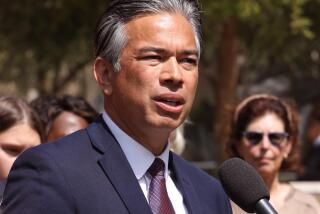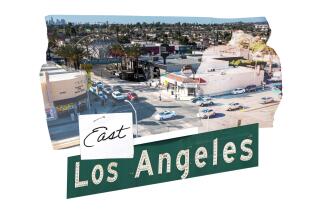Separatists Seek Bigger Wilmington of Old
- Share via
Borrowing a little moral support from recent headlines about secession efforts in the Soviet republic of Lithuania, Wilmington residents who hope to create an independent city are relishing the role of underdog.
“We are pulling a Lithuania tonight,” activist Gertrude Schwab said at a Monday night meeting of the New Wilmington Committee. “This has been talked about a lot, but we really are doing something.”
The committee, which has held six meetings, wants to secede from the City of Los Angeles, which absorbed the community in 1909. The secessionists hope to restore the borders Wilmington established when it was first incorporated in 1905. Those boundaries would include most of what is commonly known as Wilmington, plus a large chunk of the lucrative Port of Los Angeles and a swath of land west of the Harbor Freeway.
But even as committee volunteers seek to bolster their case with turn-of-the-century maps and documents gleaned from City Hall, they acknowledge they will face powerful opposition from the Los Angeles City Council. The council would have to give permission to secede, and most observers say that will never happen.
“This is a useless exercise. The city would never let Wilmington go,” said Ruth Benell, executive officer for the Local Agency Formation Commission, a county agency that prepares impact reports and legal opinions for communities that want to incorporate. The agency would determine the feasibility of Wilmington’s secession, if the City Council approves.
Although the movement has barely taken its first breath, opposition has also begun to simmer in an unexpected quarter: neighboring Harbor City.
Some residents and business owners west of the freeway say the proposed western border for a new Wilmington would swallow what they consider to be Harbor City territory, and they are promising to fight the secession campaign.
Some Harbor City residents bristle at the suggestion that they are part of Wilmington.
“It’s like the old Western days, coming in and grabbing land. They want to take away Machado Lake and Kaiser Permanente (medical center). The borders have never been defined, but those areas have always been identified as Harbor City,” said Frank Pacheco, president of the Harbor City/Harbor Gateway Chamber of Commerce.
City Councilwoman Joan Milke Flores said she believes the Wilmington group is overstepping a commonly accepted border.
“Now that Wilmington is trying to do this, it would be a good idea to make clearer boundaries,” Flores said. “I believe it is always best to have natural boundaries, and it seems in this case to be the Harbor Freeway.”
Some Harbor City residents insist they will fight for their borders.
“There is going to be a grass-roots movement, a ‘Save Harbor City’ movement,” said Joeann Valle, the chamber’s executive director. “Residents here do not want a Wilmington address.”
Although many Harbor City residents are happy to be a part of Los Angeles, Wilmington activists are smarting from years of what they see as neglect by the city.
Committee members insist they have no voice in government and do not get a fair share of revenues.
“Basically, we have had taxation without representation. Who can attend hearings downtown, 25 miles away?” Gwen Butterfield said at a committee meeting this week. “With the revenues we produce here, I think our city streets could be paved with gold, not potholes.”
Secession leaders also say Los Angeles has not lived up to many of the promises it made when it took over Wilmington in 1909. Among the promises spelled out in the consolidation documents are the immediate acquisition of a park and a pledge that an amount of money not less than taxes collected in the community would be spent on improvements there.
Both Susan Pritchard, Flores’ Wilmington deputy, and an official at the city controller’s office said revenues are not routinely broken down by community, which makes it difficult to substantiate the committee’s claims.
Wilmington residents say that Banning Park, the only park in the community, was bought by residents, not the city. Barry Simon, a planning analyst for the Recreation and Parks Department, confirmed that residents created an assessment district in 1927 to acquire the park without city money.
“Many of the commitments have never been implemented, which certainly brings into question the integrity of the consolidation election,” said Philip M. Peterson, a Long Beach resident and president of the Wilmington Historical Society. “We have been part of the city for 80 years, and streets on the east side are still not paved.”
Peterson, who has assumed the role of temporary field general for the secessionist movement, rallied about 60 people at this week’s committee meeting. He says the fight has just begun.
“The City of Los Angeles is not going to allow us to go very far, that is a given,” Peterson said. “The issue would probably have to go before the federal courts.”
Peterson said a lawsuit could revolve around two civil rights issues: the inaccessibility of local government and what he called a “correlation between the increase in Hispanic population and the decrease of funding from the city.”
With the City Council’s approval, the Wilmington group could apply to the Local Agency Formation Commission. The commission would prepare a staff report and hold a hearing. Eventually, the community would vote on the plan.
Although a number of communities have tried to secede from Southern California cities in the past 50 years, all the efforts have failed because local governments refused to let them go.
More to Read
Sign up for Essential California
The most important California stories and recommendations in your inbox every morning.
You may occasionally receive promotional content from the Los Angeles Times.













